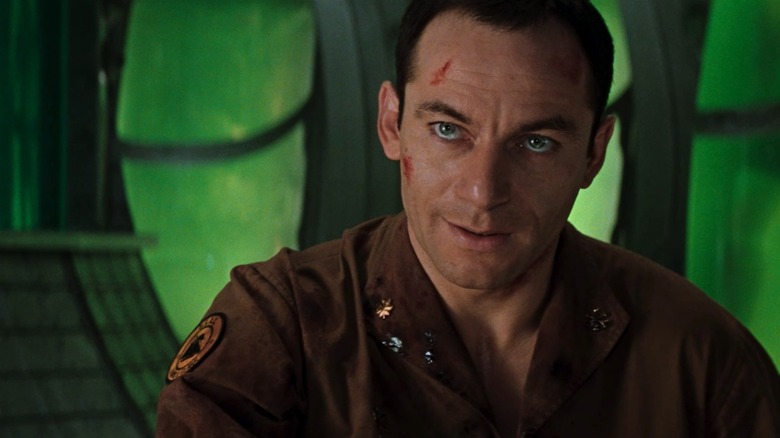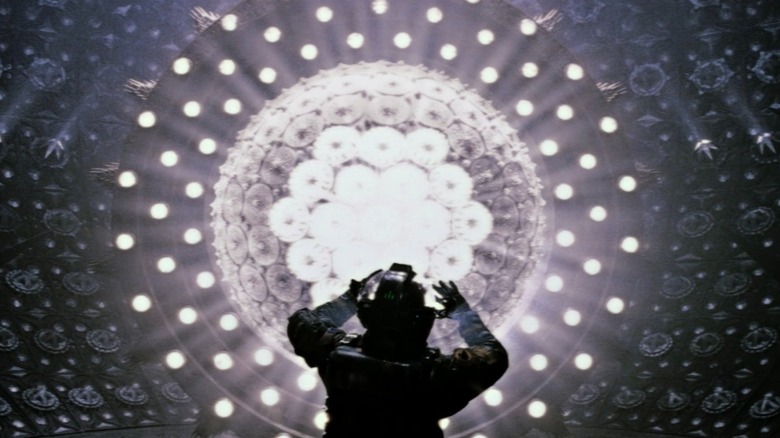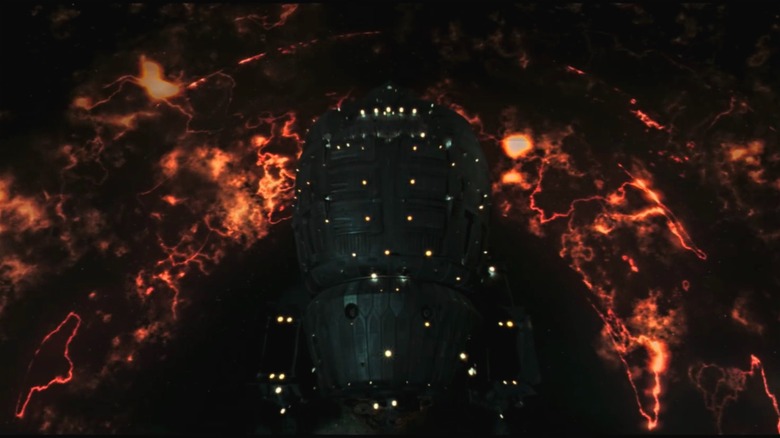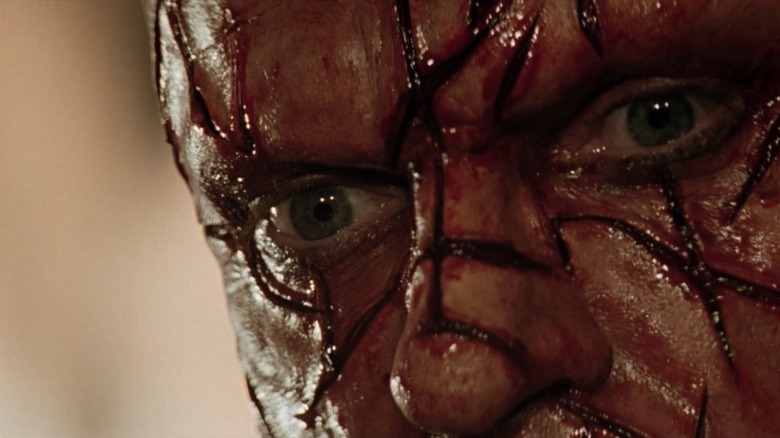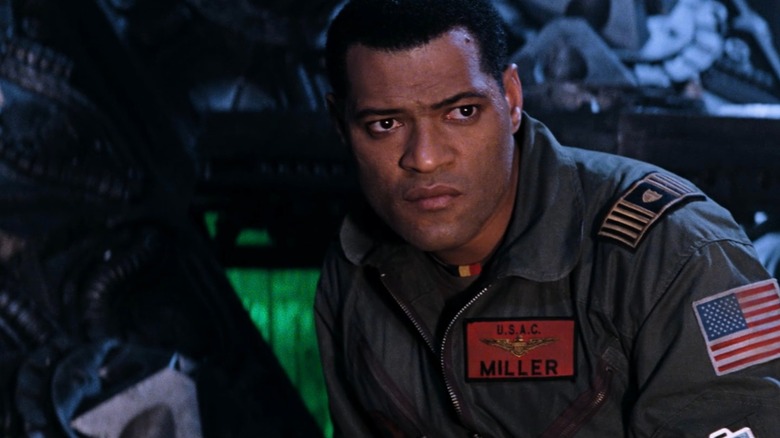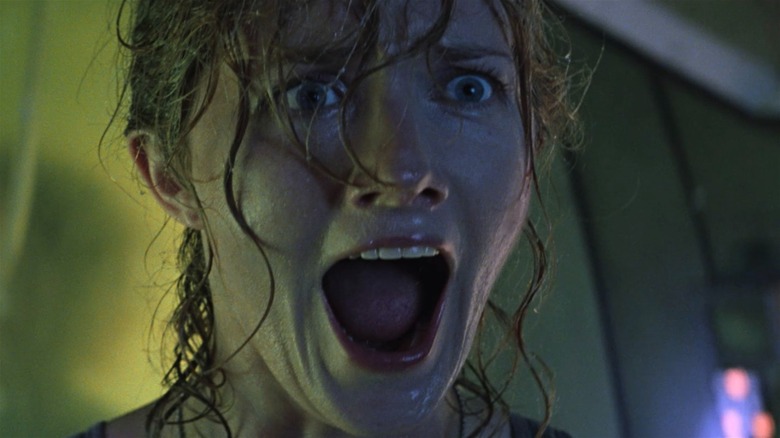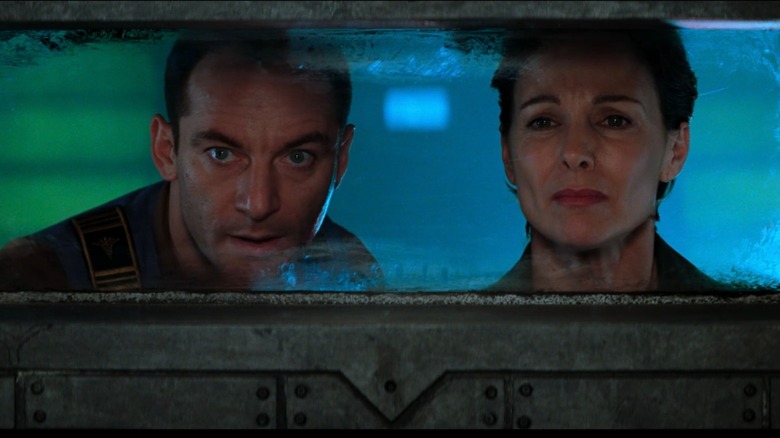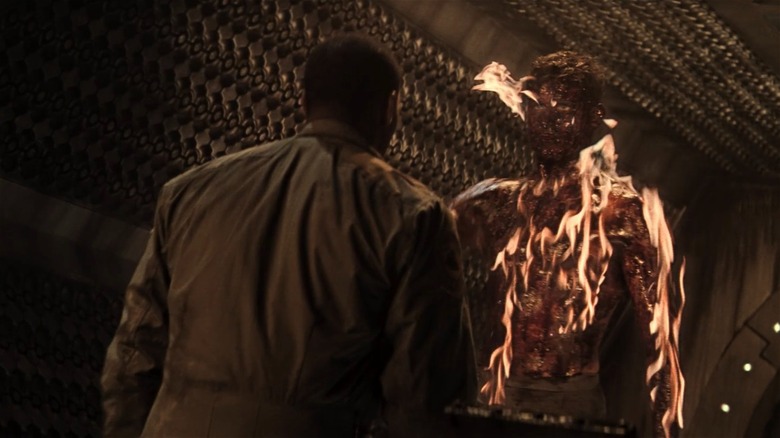Event Horizon Ending Explained: Where You're Going, You Won't Need Eyes To See
Paul W. S. Anderson's 1997 film "Event Horizon" wasn't a success when it was initially released, to put it mildly. According to The Numbers, the movie pulled in a paltry $26,673,954 globally; that doesn't even come close to matching the reported $60 million budget. On DVD, however, the film found a second life. Anderson told IndieWire, "It's a great-looking movie, and when you were watching it on VHS it didn't really have the quality that it had in the cinema. When the DVD came out the quality jumped, and I think the stark beauty finally kicked in."
He's right that "Event Horizon" is a starkly beautiful film. Thanks to some phenomenal production design and a talented cast (including Laurence Fishburne helping to keep the movie on track), the film becomes a kind of haunted house movie set in space. Other sci-fi movies released that summer included "Contact," which is ultimately a hopeful film, which is a bit ironic, considering the production seemed to be cursed. "Event Horizon," on the other hand, which premiered a few weeks later, is very bleak. It's no wonder audiences weren't feeling it.
All these years later, thanks to streaming, "Event Horizon" continues to find new fans, both on streaming and from a Blu-ray re-release. That means new people discovering the end of the film, which is far darker than most Hollywood blockbusters. It's also open to interpretation, refusing to provide the kind of closure that many audiences expect. With that in mind, let's dive in.
What you need to remember about the plot of Event Horizon
When a lost ship called the Event Horizon reappears, the ship known as the Lewis & Clark is tasked with a rescue mission. After being placed in stasis for the journey, the crew is revived when they reach Neptune. Weir (Sam Neill) designed the Event Horizon, which didn't just explore our solar system; it was part of a secret government program for faster-than-light travel. Weir developed a gravity drive, which he says can open a gateway between two points in space-time by creating a controlled black hole. Earth has now received a garbled transmission from the former crew, which seems to include Latin for "save me."
The Event Horizon sits empty, so they set about exploring the ship, determined to find out what happened to the original crew. Justin (Jack Noseworthy) is in the ship's core when the gravity drive engages, and he is pulled through a portal; when he's brought back, he warns that "the dark" is coming before trying to blow himself out the airlock. The crew starts to have psychic visions of horrific things. Peters (Kathleen Quinlan) sees her child on an examination table; Weir sees his dead wife (Holley Chant); Miller (Laurence Fishburne) sees a former crewmate named Corrick (Noah Huntley), who he knows burned to death.
The team suspects that the gateway accidentally opened a portal to Hell, giving us one of the scariest scenes in the film. The ship is now alive with demonic energy, and D.J. (Jason Isaacs) realizes what the Latin actually said: "Save yourself."
What happened at the end of Event Horizon?
The crew races to get back aboard the Clark, but Peters falls to her death and Weir has another vision of his dead wife. She blinds him; Weir goes rogue. He detonates an explosive aboard the Clark, killing Smith (Sean Pertwee) and ruining their chance of escape. Miller orders D.J. to kill Weir on sight, but Weir is too strong; he hangs D.J. from hooks in the medical bay.
Starck (Joely Richardson) and Miller confront Weir on the bridge. The spacewalking Cooper (Richard T. Jones) appears on the other side of the window, and Weir shoots it; the window explodes outward, depressurizing the room. Weir is sucked out into space while Starck and Miller manage to escape back into the ship. Cooper re-boards too, and when the gravity drive prepares to open a gateway on its own, Miller realizes they have one option: detonate explosives in the main corridor, using the foredecks as a lifeboat. Cooper and Starck prepare for stasis, but the tank in the med-bay fills with blood.
Miller, meanwhile, has another vision of Corrick, the Burning Man. A jet of fire forces him into the ship's core, where the Burning Man transforms into Weir. He tortures Miller with visions of Hell and is about to deliver the killing blow when Miller hits the detonator. The corridor explodes, allowing the foredecks to escape as the Event Horizon vanishes into a wormhole. Months later, Starck and Cooper appear to be rescued.
How did Weir come back? Wasn't he dead?
When the possessed Dr. Weir tries to kill Cooper by shooting through the window of the bridge, he decompresses the entire room and is sucked out into space. However, moments later, he turns up again next to the core, in disguise as Miller's dead colleague Corrick. When Miller correctly protests, insisting he saw Corrick die, the figure transforms back into Weir. How can this be possible, if we also just witnessed Weir die?
Weir addresses this very question, telling Miller, "The ship brought me back. I told you, she won't let me leave. She won't let anyone leave." He means that the ship has a hold over him, refusing to allow his soul to escape the gravitational portal to Hell. However, that still doesn't explain how he was able to disguise himself as Miller's dead friend; that's a power we haven't seen the possessed scientist display yet.
Instead, it might make sense to view Weir's appearance at the end as another psychic vision, another manifestation of the entity aboard the Event Horizon haunting Miller's mind as it tries to destroy his body. After all, the door to the core has clearly closed, but Weir appears on this side of it, suggesting that his body isn't physical. He also shows Miller visions of the Hell dimension, proving that he can influence the other man's psyche.
What happens to Miller at the end of Event Horizon?
As Miller and Weir battle it out, Weir reveals that it isn't a gateway to Hell after all, but something far scarier. "You know nothing," he says. "Hell is only a word. The reality is much, much worse." Weir gives Miller visions of his crew being tortured in a variety of shocking, graphic ways that flash by almost too quickly to register. In the final seconds before the gravity drive opens the gateway, Miller manages to detonate the corridor. But what happens to him after the foredecks separate from the main ship?
The short answer is: we don't really know. After the corridor blows up, we never get a shot back inside the core. The last thing we see is that Weir looks shocked by Miller's actions, suggesting that he's managed to pull one over on the demonic entity. From space, we see the ship overcome with lightning. Then, it blooms into light as it descends into what appears to be a wormhole in Neptune's atmosphere.
It's a pretty bleak ending, suggesting that the core did indeed open the gateway back to whatever horrific, worse-than-Hell dimension the Event Horizon initially visited. Remember, the "gateway" is technically a controlled black hole; that's what the wormhole in Neptune's atmosphere appears to resemble, warping space-time around itself and then closing back up. Whether the ship traveled through or simply crashed onto the planet's surface, we can safely assume Miller is now dead.
What does Stark's vision mean?
At the very end of "Event Horizon," the film flashes forward a few months. A team called Rescue 1 boards the remains of the ship, and they discover three crew members still alive in stasis: Starck, Justin, and Cooper. Starck is released first, and when the rescuer takes off his helmet, she's horrified to see that it's Weir. Then, she appears to wake up again, and Cooper comforts her, telling her they're safe now. The camera pulls back through the door, which closes, seemingly on its own.
There are two main ways to interpret this. The most obvious is that it's just a dream, that Starck is psychically haunted by her experience. Even though they've managed to escape the evil ship, the memories of what she's seen will continue to follow her.
Alternately, it could be that they didn't manage to escape at all. We've seen horrific visions take place all across the Event Horizon, so there's not really any reason to believe that the evil entity was wholly contained in the core when Miller managed to detonate the corridor. We've also seen that the living ship managed to manipulate its own electronics all over. In that case, the closing door at the very end could indicate that this part of the ship is very much still alive, very much still possessed with a demonic mind of its own. After all, as Weir told Miller, "She won't let anyone leave."
What has the director said about the end of Event Horizon?
For the movie's 25th anniversary, director Paul W.S. Anderson told Variety that he always knew the film's ending was going to be polarizing. "I don't think we were ever going to test great because the end of the movie is a bit of a downer. When you disturb an audience they're not going to go, 'Oh that was an excellent cinema-going experience,'" he reasoned.
Still, the director theorized that the movie's bleak ending is part of why it's managed to develop a cult following after "Titanic" put a damper on its box office prospects. "We delivered a movie that really stayed with people," he said. "I think that over time it's been appreciated for that."
That all being said, Anderson told FilmSpeak that he wouldn't necessarily make the movie the same way again. "I think it would be hard for me to embrace some of the really dark imagery in the film. I'm a father with three children now," he said. "I was a young man who had a certain darkness within me that the movie really allowed to come out."
Event Horizon's alternate endings
Infamously, a number of scenes were shot for "Event Horizon" that didn't make it into the finished film. Unfortunately, a lot of the footage was lost, which means there's a version of the movie we'll never see. "On VHS there was no room for all of these deleted scenes, there was no reason for the studio to keep it," Paul W.S. Anderson told Entertainment Weekly. "They hadn't archived a lot of that stuff. So it's just not there."
Still, we do know about two alternate endings that were considered for the film. In the original shooting script, the film ended on a scene where the rescued Starck hears the screams of her murdered colleagues. "Starck awakens but the SCREAMS continue as the Event Horizon calls out to her ... she SCREAMS ... hands on her body ..." the script reads. This time, rather than Cooper telling her, "We're safe," the concluding line of the film was, "It's over." This ending would have more strongly implied that any lingering danger was in Starck's mind.
The other alternate ending involves Miller's final confrontation with Weir near the gravity drive. In a commentary track for the deleted scene (via YouTube), Anderson revealed that the fight was supposed to be only with the Burning Man, rather than with Weir. "It made the movie more specifically about these people ... having to deal with the return of their sins, and being tormented by, what were their sins, and what they perceived as being their guilts and their sins," he explained.
In the end, we're pretty pleased with the version of "Event Horizon" that ended up coming together.
